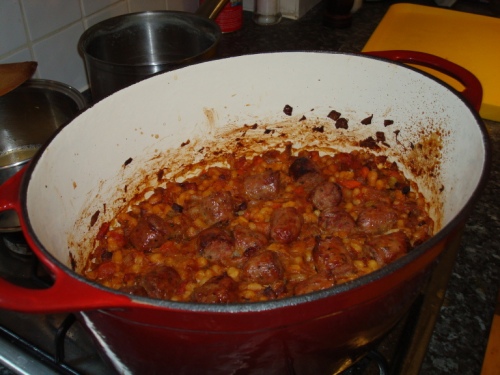A kind of elemental cassoulet, this is a good thing to cook when you’ve got a large hungry group to deal with. Maybe your church choir has been playing drinking games in the crypt. Who knows. To feed sixteen (not the sixteen) you’ll need the following quantities:
- 3kg pork sausages (they need to be moderately fatty, some expensive sausages are commendably lean, but no good for this recipe)
- 1kg onions
- 1kg carrots
- 1 large head of celery (800g or more)
- 1kg tinned chopped tomatoes and their juices
- 1kg tinned canellini beans (that’s four 450g tins’ worth)
- one head of garlic (or as much as you dare)
- a bunch of thyme
- a few dried bay leaves
You can cook this in two stages:
- Start by putting the sausages into a large roasting tin (single layer is best) and into the oven at Gas 6. They’ll need around an hour – but check and turn them every fifteen minutes or so. We’re aiming for dark wrinkly skins and sticky fatty juices at the bottom of the tin. So maybe they’ll need longer.
- Meanwhile, chop up the carrots, onion and celery: no need to dice, just 1cm pieces. I don’t bother peeling the carrots, but just give them a good scrub to get any dirt off the outside. Peel the individual garlic cloves; no need to chop or crush.
- When the sausages are done, fish them out of the roasting tin, and leave them somewhere to cool. The tin should have a layer of fat in it, do not discard.
- Put the carrots into the tin, combine with the sausage fat, and return to the oven for half an hour. Carrots are tough little bastards, and they need a head start.
- Add the onions, celery, garlic and bay leaves, plus salt and pepper. Return to the oven for another half an hour. Check them regularly and turn every ten minutes or so, making sure they’re lightly coated with the sausage fat. Again, we’re aiming to get them properly cooked, and lightly caramelised, with a hint of brown about the edges. Onions have a slight tendency to burn, so feel free to reduce the temperature if they’re browning too fast.
- When they’re done, decant them, and if there’s a particularly good fond on the roasting tin, then deglaze it with a little hot water, reduce, and add that liquid to the veg.
At this point you can stop, and park the cooked sausage and veg into a large container. When you’re ready to continue:
- Into a large pot, pour in the tinned tomatoes, and about a litre of water, bring to the boil, and simmer for about half an hour. (This is just to get the tomatoes properly cooked, which makes them sweeter and less acidic.)
- Add all the other ingredients: roast sausages, roast veg, beans, herbs.
- Gently simmer, stirring from time to time, until everything is hot, and you’re ready to go.
A few things to note:
- If you want to double the quantity of garlic, then go for it. Double it again if you need. Go on. You know you want to.
- You can perform the second stage in the oven if you have a large enough roasting tin, or tins. Make sure that the meat and veg are poking above the liquid, and the heat from the oven will make them get sticky and crisp.
- You could replace the sausage with an equal quantity of hacked up pork shoulder.
- If you want to use dried beans, then you’ll need to soak and cook in advance.


